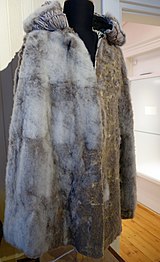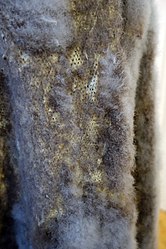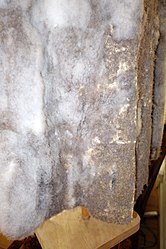Swan fur by Clara Schumann
The Swan fur Clara Schumann , a goose down Cape, originally owned by the German pianist and composer Clara Schumann , née Wieck (1819-1896), the wife of composer Robert Schumann . Today it is part of the Dickinson Collection in the holdings of the Heinrich Heine Institute in Düsseldorf . The institute is diagonally across from the Schumann House , where the Schumann couple lived from 1852 to 1855.
General
In the time of Clara Schumann († 1896) - and several years afterwards - it was still common that not only the bird feathers were used as decorative accessories for clothes, boas and headgear, but also the bird skins, referred to as bird skins by the fur-processing furriers . It was mainly used to produce smaller sets and trimmings, and more rarely also larger pieces such as Clara's swan cape. A skinning company that was particularly concerned with the production of bird skin fur was the Norwegian company Brandt in the city of Bergen , which was still producing capes from bird skin in 1923 . The splendid swan fur that Marlene Dietrich wore on her world tour has become better known than the Schumann's cape , also during her highly acclaimed first appearance in post-war Germany in 1960 in Berlin.
The bird species mainly used for fur processing were goose , grebes , eider , cormorant and swan , whereby not only the swan skins but also the goose skins were traded as swan fur.
With all bird skin types, the stiff upper feathers were usually plucked out before processing, so that only the soft down feathers remained.
history
The swan fur was made for Mrs. Schumann. She should have worn it on festive occasions in general. When the part was first presented to the press, Sabrine Brenner-Wilczek, the director of the Heinrich Heine Institute, said: "Back then, the coat kept you warm in the drafty concert halls".
Long after the death of Clara Schumann, the Cape passed from the Schumann heirs to the American couple June and Edward Dickinson. The journalist Dickinson had given his newlywed wife, who was studying music education and therapy, an original Robert Schumann manuscript for Christmas 1947. From this developed the decades-long, intense interest in the composer couple with the Dickinsons. They made contact with Ferdinand Schumann (* 1875, † 1954), one of Schumann's grandchildren who lived in Reinsberg near Zwickau , Schumann's birthplace. In the GDR many products were scarce or not available at all. The Dickinsons sent Ferdinand Schumann groceries, and he returned the favor with a series of letters from the Schumann estate. Robert Sommerhoff (* 1878; † 1962), another grandson of Schumann living in the USA, left them additional pieces from the Schumann inheritance. They bought other parts from antiquarians. In 1949 the Dickinsons set up a foundation; henceforth they organized concerts and published publications in memory of the Schumanns. They also started building a Schumann Museum. These numerous activities ultimately exceeded their financial means and the couple became impoverished. At the time of Edward Dickinson's death in 1975, the exhibits were packed and stored largely unnoticed. In letters to many addressees, the widow later reported the existence of the collection in her house in the "Finger Lakes" area near Livonia in New York State.
The city of Düsseldorf is particularly connected to the history of the Schumann couple and they were therefore very interested in the collection. Robert Schumann worked from September 1850 to October 1854 as Municipal Music Director in Düsseldorf. In 1856 Robert Schumann died in a mental hospital in Endenich , today part of Bonn, about 80 kilometers up the Rhine from Düsseldorf, his wife was still living in Düsseldorf at the time.
After years of negotiations, the Dickinson Collection was acquired by the Düsseldorf Heinrich Heine Institute with funds from the Federal Republic of Germany, the State of North Rhine-Westphalia and the City of Düsseldorf, where it arrived in 1984 and was merged with the Schumann Archive that already existed there. In addition to the swan cape, the will of Clara Schumann, numerous prints and manuscripts, paintings and much more belong to the objects taken over with the Dickinson collection.
description
In the last press releases, Clara Schumann's so-called swan fur is referred to as a coat. In the introduction to the inventory of the Dickinson collection by the Americans Locke and Thym, however, the part is correctly referred to as a swan down cape ("swansdown cape"). The festive garment has no sleeves, it is a long, hip-length cape with a firmly attached hood.
The feather fur
The actual bird species has not yet been determined. It may not be a swan, as the downy chicks have light silver-gray plumage, but with a white underside. Young birds that are not yet fully grown have dull gray-brown plumage that becomes increasingly lighter in the course of the first year of life. The brown feathers are gradually lost. The young swans only show completely white plumage in the second year of life after the full moult . For pelts from animals more than a year old, the pelts may appear too small. A high probability speaks in favor of goose, perhaps from Dutch breeding (goose hides were traded as swan fur), eider duck or cormorant would also be possible, for example.
The exterior processing
Four rows of skins were placed on top of each other, and about 25 skins were used in the bottom row. From the outside it is difficult to tell whether the skins were sewn by hand or with the fur sewing machine introduced around 1900 . If one assumes that Clara Schumann wore the cape to her concert appearances, the last concert was in 1891, it is pretty certain that the skins were still sewn together by hand.
The hood is made of striped feather fur and smocked velvet .
The fur only had the soft, white down feathers, the holes in the leather from the quills removed before processing are clearly visible. Any previous color shades are not (anymore?) Recognizable.
The interior processing
Until about the middle of the 20th century, it was still customary to design the interior of such a valuable item of clothing as fur in a suitably complex manner. The lining is quite strong for an evening gown, but numerous decorative folds and applications decorate it. At least on the inside right side there is a cross pocket at the bottom and a long pocket at the top. Both pockets have an opening made of pleated silk with decorative silk loops on both sides.
State of preservation
The feather fur has suffered a lot in the meantime. The down looks as if it was mostly rubbed off from wearing; Only in a few places is a closed duvet preserved, in some cases it is completely bare. The right front part is best preserved. In fact, the cape was probably destroyed by insect damage, the fur is said to have arrived in Düsseldorf very heavily eaten by (and with then still existing) insects in the hair. There are also small isolated abrasion or moth holes in the visible part of the fabric. The fur is kept on a tailor's bust and shown that way on request.
Apart from the largely disappeared feather down and the associated, poor appearance, the part is in an astonishingly good condition, at least in terms of leather, cracks that are actually to be expected cannot be seen on a superficial view. Perhaps the rather stable-looking lining promotes the cohesion of the leather. However, bird skins have a significantly stiffer leather than hairy skins, so that they may not suffer the same aging as these, i.e. they are not as rotten and therefore sensitive to tearing.
- The places where the quills were plucked before processing are clearly visible as dark spots
Web links
Individual evidence
- ↑ Editor: Historical fur fashion show in London. Heft 66/67, p. 5, June 11, 1932 and Kormoranmäntel . Issue 74, p. 3, June 29, 1932, In: Der Rauchwarenmarkt.
- ↑ Colja Schliewa: This is Düsseldorf's Schumann treasure . In: Express , Düsseldorf edition, February 4, 2016. Accessed April 16, 2017.
- ↑ a b Regine Müller: The plaster is crumbling in Schumann's house . Rheinische Post , February 4, 2016. Accessed April 16, 2016.
- ↑ a b pdl: From the USA to Düsseldorf. A treasure on the subject of Schumann . In: Das Tor , No. 4, 1985, pp. 8, 10.
- ↑ Ralph P. Locke, Jürgen Thym: A First Report on the Dickinson Collection, with Catalogs of its Manuscript Holdings. New Schumann Materials in Upstate New York. In: Fontes Artis Musicae Vol. 27, No. 3/4, July-December 1980, p. 140 (English).










